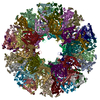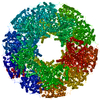+ Open data
Open data
- Basic information
Basic information
| Entry | Database: EMDB / ID: EMD-0138 | |||||||||
|---|---|---|---|---|---|---|---|---|---|---|
| Title | core of the human pyruvate dehydrogenase | |||||||||
 Map data Map data | ||||||||||
 Sample Sample |
| |||||||||
 Keywords Keywords | Pyruvate dehydrogenase / human / OXIDOREDUCTASE | |||||||||
| Function / homology |  Function and homology information Function and homology informationPDH complex synthesizes acetyl-CoA from PYR / dihydrolipoyllysine-residue acetyltransferase / dihydrolipoyllysine-residue acetyltransferase activity / Regulation of pyruvate dehydrogenase (PDH) complex / pyruvate catabolic process / Protein lipoylation / pyruvate decarboxylation to acetyl-CoA / pyruvate dehydrogenase complex / Signaling by Retinoic Acid / acyltransferase activity ...PDH complex synthesizes acetyl-CoA from PYR / dihydrolipoyllysine-residue acetyltransferase / dihydrolipoyllysine-residue acetyltransferase activity / Regulation of pyruvate dehydrogenase (PDH) complex / pyruvate catabolic process / Protein lipoylation / pyruvate decarboxylation to acetyl-CoA / pyruvate dehydrogenase complex / Signaling by Retinoic Acid / acyltransferase activity / tricarboxylic acid cycle / glucose metabolic process / mitochondrial matrix / mitochondrion / nucleoplasm / identical protein binding / plasma membrane Similarity search - Function | |||||||||
| Biological species |  Homo sapiens (human) Homo sapiens (human) | |||||||||
| Method | single particle reconstruction / cryo EM / Resolution: 6.0 Å | |||||||||
 Authors Authors | Haselbach D / Prajapati S | |||||||||
| Funding support |  Germany, 1 items Germany, 1 items
| |||||||||
 Citation Citation |  Journal: Structure / Year: 2019 Journal: Structure / Year: 2019Title: Structural and Functional Analyses of the Human PDH Complex Suggest a "Division-of-Labor" Mechanism by Local E1 and E3 Clusters. Authors: Sabin Prajapati / David Haselbach / Sabine Wittig / Mulchand S Patel / Ashwin Chari / Carla Schmidt / Holger Stark / Kai Tittmann /   Abstract: The pseudo-atomic structural model of human pyruvate dehydrogenase complex (PDHc) core composed of full-length E2 and E3BP components, calculated from our cryoelectron microscopy-derived density maps ...The pseudo-atomic structural model of human pyruvate dehydrogenase complex (PDHc) core composed of full-length E2 and E3BP components, calculated from our cryoelectron microscopy-derived density maps at 6-Å resolution, is similar to those of prokaryotic E2 structures. The spatial organization of human PDHc components as evidenced by negative-staining electron microscopy and native mass spectrometry is not homogeneous, and entails the unanticipated formation of local clusters of E1:E2 and E3BP:E3 complexes. Such uneven, clustered organization translates into specific duties for E1-E2 clusters (oxidative decarboxylation and acetyl transfer) and E3BP-E3 clusters (regeneration of reduced lipoamide) corresponding to half-reactions of the PDHc catalytic cycle. The addition of substrate coenzyme A modulates the conformational landscape of PDHc, in particular of the lipoyl domains, extending the postulated multiple random coupling mechanism. The conformational and associated chemical landscapes of PDHc are thus not determined entirely stochastically, but are restrained and channeled through an asymmetric architecture and further modulated by substrate binding. | |||||||||
| History |
|
- Structure visualization
Structure visualization
| Movie |
 Movie viewer Movie viewer |
|---|---|
| Structure viewer | EM map:  SurfView SurfView Molmil Molmil Jmol/JSmol Jmol/JSmol |
| Supplemental images |
- Downloads & links
Downloads & links
-EMDB archive
| Map data |  emd_0138.map.gz emd_0138.map.gz | 58.9 MB |  EMDB map data format EMDB map data format | |
|---|---|---|---|---|
| Header (meta data) |  emd-0138-v30.xml emd-0138-v30.xml emd-0138.xml emd-0138.xml | 11.1 KB 11.1 KB | Display Display |  EMDB header EMDB header |
| Images |  emd_0138.png emd_0138.png | 58.4 KB | ||
| Filedesc metadata |  emd-0138.cif.gz emd-0138.cif.gz | 5.7 KB | ||
| Archive directory |  http://ftp.pdbj.org/pub/emdb/structures/EMD-0138 http://ftp.pdbj.org/pub/emdb/structures/EMD-0138 ftp://ftp.pdbj.org/pub/emdb/structures/EMD-0138 ftp://ftp.pdbj.org/pub/emdb/structures/EMD-0138 | HTTPS FTP |
-Validation report
| Summary document |  emd_0138_validation.pdf.gz emd_0138_validation.pdf.gz | 231.3 KB | Display |  EMDB validaton report EMDB validaton report |
|---|---|---|---|---|
| Full document |  emd_0138_full_validation.pdf.gz emd_0138_full_validation.pdf.gz | 230.4 KB | Display | |
| Data in XML |  emd_0138_validation.xml.gz emd_0138_validation.xml.gz | 6 KB | Display | |
| Arichive directory |  https://ftp.pdbj.org/pub/emdb/validation_reports/EMD-0138 https://ftp.pdbj.org/pub/emdb/validation_reports/EMD-0138 ftp://ftp.pdbj.org/pub/emdb/validation_reports/EMD-0138 ftp://ftp.pdbj.org/pub/emdb/validation_reports/EMD-0138 | HTTPS FTP |
-Related structure data
| Related structure data |  6h55MC  6h60MC M: atomic model generated by this map C: citing same article ( |
|---|---|
| Similar structure data |
- Links
Links
| EMDB pages |  EMDB (EBI/PDBe) / EMDB (EBI/PDBe) /  EMDataResource EMDataResource |
|---|---|
| Related items in Molecule of the Month |
- Map
Map
| File |  Download / File: emd_0138.map.gz / Format: CCP4 / Size: 64 MB / Type: IMAGE STORED AS FLOATING POINT NUMBER (4 BYTES) Download / File: emd_0138.map.gz / Format: CCP4 / Size: 64 MB / Type: IMAGE STORED AS FLOATING POINT NUMBER (4 BYTES) | ||||||||||||||||||||||||||||||||||||||||||||||||||||||||||||
|---|---|---|---|---|---|---|---|---|---|---|---|---|---|---|---|---|---|---|---|---|---|---|---|---|---|---|---|---|---|---|---|---|---|---|---|---|---|---|---|---|---|---|---|---|---|---|---|---|---|---|---|---|---|---|---|---|---|---|---|---|---|
| Projections & slices | Image control
Images are generated by Spider. | ||||||||||||||||||||||||||||||||||||||||||||||||||||||||||||
| Voxel size | X=Y=Z: 1.27 Å | ||||||||||||||||||||||||||||||||||||||||||||||||||||||||||||
| Density |
| ||||||||||||||||||||||||||||||||||||||||||||||||||||||||||||
| Symmetry | Space group: 1 | ||||||||||||||||||||||||||||||||||||||||||||||||||||||||||||
| Details | EMDB XML:
CCP4 map header:
| ||||||||||||||||||||||||||||||||||||||||||||||||||||||||||||
-Supplemental data
- Sample components
Sample components
-Entire : single particle cryo EM-derived map of the full-length native hum...
| Entire | Name: single particle cryo EM-derived map of the full-length native human E2-E3BP core of the pyruvate dehydrogenase multienzyme complex |
|---|---|
| Components |
|
-Supramolecule #1: single particle cryo EM-derived map of the full-length native hum...
| Supramolecule | Name: single particle cryo EM-derived map of the full-length native human E2-E3BP core of the pyruvate dehydrogenase multienzyme complex type: complex / ID: 1 / Parent: 0 / Macromolecule list: all |
|---|---|
| Source (natural) | Organism:  Homo sapiens (human) Homo sapiens (human) |
-Macromolecule #1: Dihydrolipoyllysine-residue acetyltransferase component of pyruva...
| Macromolecule | Name: Dihydrolipoyllysine-residue acetyltransferase component of pyruvate dehydrogenase complex, mitochondrial type: protein_or_peptide / ID: 1 / Number of copies: 1 / Enantiomer: LEVO / EC number: dihydrolipoyllysine-residue acetyltransferase |
|---|---|
| Source (natural) | Organism:  Homo sapiens (human) Homo sapiens (human) |
| Molecular weight | Theoretical: 69.069398 KDa |
| Recombinant expression | Organism:  |
| Sequence | String: MWRVCARRAQ NVAPWAGLEA RWTALQEVPG TPRVTSRSGP APARRNSVTT GYGGVRALCG WTPSSGATPR NRLLLQLLGS PGRRYYSLP PHQKVPLPSL SPTMQAGTIA RWEKKEGDKI NEGDLIAEVE TDKATVGFES LEECYMAKIL VAEGTRDVPI G AIICITVG ...String: MWRVCARRAQ NVAPWAGLEA RWTALQEVPG TPRVTSRSGP APARRNSVTT GYGGVRALCG WTPSSGATPR NRLLLQLLGS PGRRYYSLP PHQKVPLPSL SPTMQAGTIA RWEKKEGDKI NEGDLIAEVE TDKATVGFES LEECYMAKIL VAEGTRDVPI G AIICITVG KPEDIEAFKN YTLDSSAAPT PQAAPAPTPA ATASPPTPSA QAPGSSYPPH MQVLLPALSP TMTMGTVQRW EK KVGEKLS EGDLLAEIET DKATIGFEVQ EEGYLAKILV PEGTRDVPLG TPLCIIVEKE ADISAFADYR PTEVTDLKPQ VPP PTPPPV AAVPPTPQPL APTPSAPCPA TPAGPKGRVF VSPLAKKLAV EKGIDLTQVK GTGPDGRITK KDIDSFVPSK VAPA PAAVV PPTGPGMAPV PTGVFTDIPI SNIRRVIAQR LMQSKQTIPH YYLSIDVNMG EVLLVRKELN KILEGRSKIS VNDFI IKAS ALACLKVPEA NSSWMDTVIR QNHVVDVSVA VSTPAGLITP IVFNAHIKGV ETIANDVVSL ATKAREGKLQ PHEFQG GTF TISNLGMFGI KNFSAIINPP QACILAIGAS EDKLVPADNE KGFDVASMMS VTLSCDHRVV DGAVGAQWLA EFRKYLE KP ITMLL UniProtKB: Dihydrolipoyllysine-residue acetyltransferase component of pyruvate dehydrogenase complex, mitochondrial |
-Experimental details
-Structure determination
| Method | cryo EM |
|---|---|
 Processing Processing | single particle reconstruction |
| Aggregation state | particle |
- Sample preparation
Sample preparation
| Buffer | pH: 8 |
|---|---|
| Grid | Model: Quantifoil R3.5/1 / Support film - #0 - Film type ID: 1 / Support film - #0 - Material: CARBON / Support film - #0 - topology: CONTINUOUS / Support film - #1 - Film type ID: 2 / Support film - #1 - Material: CARBON / Support film - #1 - topology: HOLEY |
| Vitrification | Cryogen name: ETHANE |
- Electron microscopy
Electron microscopy
| Microscope | FEI TITAN KRIOS |
|---|---|
| Specialist optics | Spherical aberration corrector: Microscope was modified with a Cs corrector with two hexapole elements |
| Image recording | Film or detector model: FEI FALCON II (4k x 4k) / Detector mode: INTEGRATING / Number grids imaged: 1 / Number real images: 2250 / Average exposure time: 1.0 sec. / Average electron dose: 41.0 e/Å2 |
| Electron beam | Acceleration voltage: 300 kV / Electron source:  FIELD EMISSION GUN FIELD EMISSION GUN |
| Electron optics | Illumination mode: SPOT SCAN / Imaging mode: BRIGHT FIELD / Cs: 0.01 mm |
| Experimental equipment |  Model: Titan Krios / Image courtesy: FEI Company |
- Image processing
Image processing
| Startup model | Type of model: INSILICO MODEL |
|---|---|
| Final reconstruction | Applied symmetry - Point group: I (icosahedral) / Algorithm: FOURIER SPACE / Resolution.type: BY AUTHOR / Resolution: 6.0 Å / Resolution method: FSC 0.143 CUT-OFF / Number images used: 29788 |
| Initial angle assignment | Type: ANGULAR RECONSTITUTION |
| Final angle assignment | Type: PROJECTION MATCHING |
 Movie
Movie Controller
Controller













 Z (Sec.)
Z (Sec.) Y (Row.)
Y (Row.) X (Col.)
X (Col.)





















